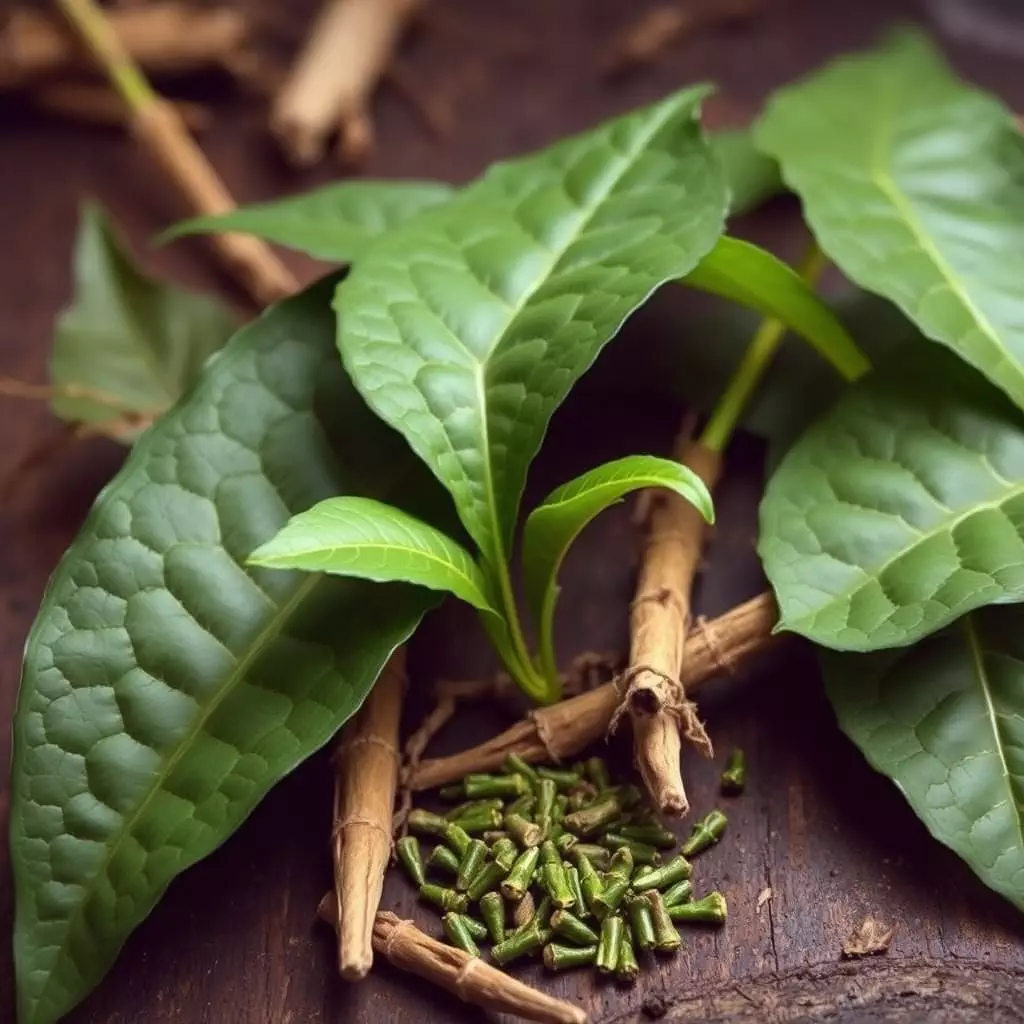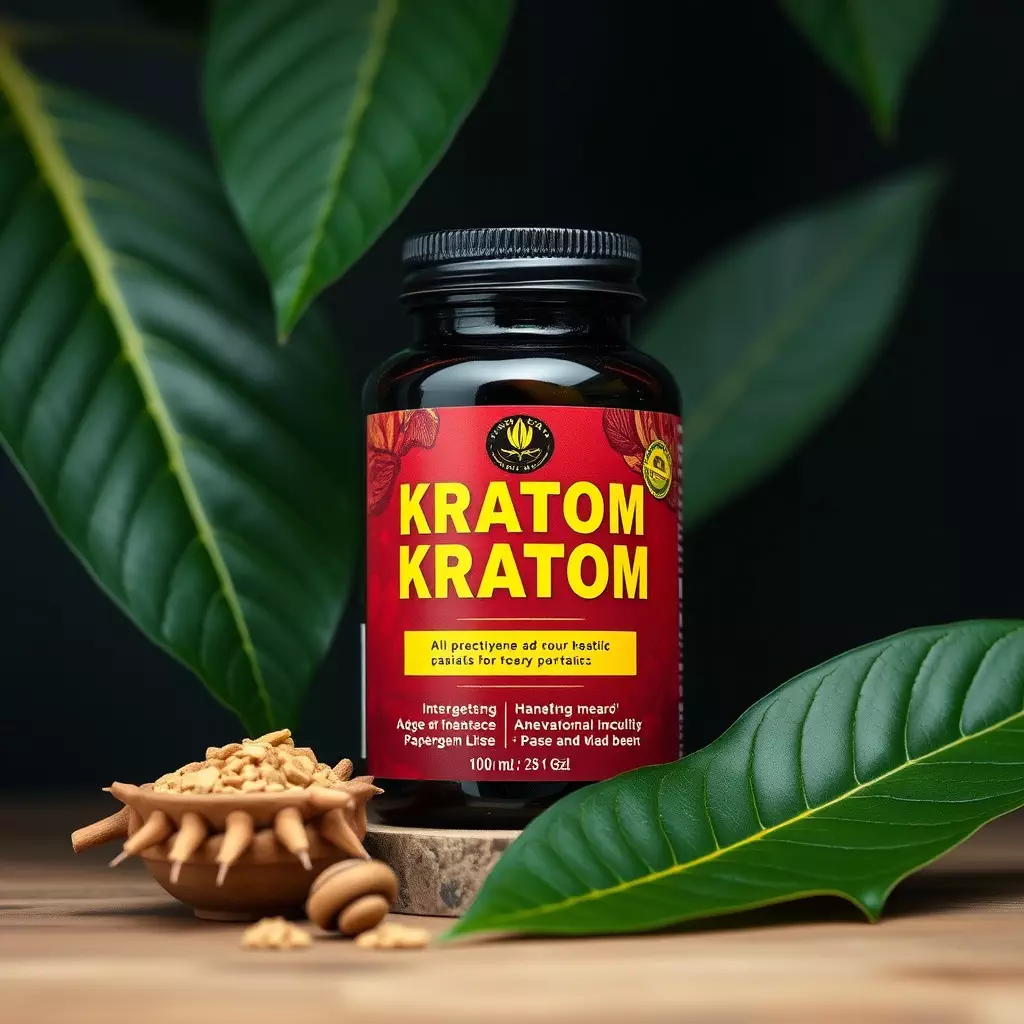Kratom, derived from Southeast Asian plants, has garnered attention for its potential role in enhancing training recovery through its alkaloids mitragynine and 7-hydroxymitragynine, which interact with opioid receptors to alleviate muscle soreness and fatigue post-exercise. These compounds also offer pain relief, promote relaxation without drowsiness, and support restorative sleep, all of which are crucial for muscle tissue regeneration in athletes and fitness enthusiasts. Kratom's energy-boosting properties, particularly from the alkaloids mitraphylline and 7-hydroxymitragynine, can aid in endurance and recovery during rigorous training, with some strains also exhibiting anti-inflammatory effects that may accelerate muscle healing. However, it's important to use kratom with caution due to its dose-dependent effects and individual variability in response. Athletes should consult healthcare professionals for optimal dosage and strain selection to integrate kratom safely into their training recovery regimen, which should encompass proper nutrition, hydration, and rest. Kratom should be used responsibly, with consideration of personal tolerance, legal status, heat sensitivity during exercise, potential interactions with other medications or supplements, and overall health monitoring to avoid dependency and ensure that it supports rather than complicates the recovery process.
Exploring the multifaceted relationship between kratom and athletic training recovery, this article delves into how this botanical can potentially augment muscle regeneration. We’ll dissect the mechanisms behind select kratom strains that may aid in mitigating fatigue and expediting healing processes in athletes. Additionally, we’ll outline safe dosage guidelines and best practices for incorporating kratom into post-training routines to enhance recovery. Join us as we navigate the intersection of natural supplementation and physical performance optimization.
- Understanding Kratom's Role in Enhancing Muscle Recovery Post-Training
- Mitigating Fatigue and Accelerating Healing with Kratom Strains for Athletes
- Safe Kratom Dosage and Best Practices for Integration into a Training Recovery Routine
Understanding Kratom's Role in Enhancing Muscle Recovery Post-Training
Mitigating muscle fatigue and expediting recovery are pivotal for athletes and fitness enthusiasts alike. Kratom, a plant originating from Southeast Asia, has garnered attention for its potential role in training recovery with kratom. Alkaloids found within kratom leaves, particularly mitragynine and 7-hydroxymitragynine, are believed to interact with the body’s opioid receptors, which may contribute to pain relief and reduced muscle soreness post-exercise. This interaction can potentially alleviate discomfort associated with intense training sessions, allowing for quicker recovery periods. Furthermore, kratom is thought to influence the central nervous system, promoting a state of relaxation without inducing drowsiness, which can be conducive to restorative sleep and aiding in the regeneration of muscle tissues. Users often report that incorporating kratom into their routine facilitates a more efficient recovery process, enabling them to maintain their training regimen with reduced risk of overtraining or injury due to insufficient recuperation time. However, it is imperative to approach the use of kratom with caution, as its effects can be dose-dependent and vary between individuals. The scientific community continues to explore the full scope of kratom’s effects on muscle recovery, advocating for a balanced understanding through rigorous clinical research to substantiate its role in training recovery with kratom.
Mitigating Fatigue and Accelerating Healing with Kratom Strains for Athletes

Kratom, a plant native to Southeast Asia, has garnered attention within athletic communities for its potential role in training recovery with kratom. Certain strains of kratom are believed to mitigate fatigue by interacting with the opioid receptors in the brain, which can help athletes push through intense training sessions without overexertion. The alkaloids present in kratom leaves, such as 7-hydroxymitragynine and mitraphylline, are thought to provide a balanced energy boost that supports endurance while minimizing the risk of injury due to overuse or fatigue. This careful modulation of energy levels can be particularly beneficial for athletes during recovery periods, allowing them to rest effectively between training sessions without losing their edge.
In addition to its energizing properties, kratom is also being explored for its potential to accelerate healing in overworked muscles and joints. Some strains, notably those with higher concentrations of 7-hydroxymitragynine, are said to possess anti-inflammatory effects that can aid in reducing muscle soreness and swelling. This can be a boon for athletes seeking natural ways to enhance their recovery process, as it may enable them to return to training sooner after intense physical activity. It’s important for athletes to consult with healthcare professionals before incorporating kratom into their regimen, as dosage and strain selection are critical factors in achieving the desired effects without adverse side effects. Training recovery with kratom should be a carefully considered part of an overall recovery strategy that includes proper nutrition, hydration, rest, and other recuperative practices.
Safe Kratom Dosage and Best Practices for Integration into a Training Recovery Routine

When integrating kratom into a training recovery routine, adhering to safe dosage guidelines is paramount for optimal results and minimizing potential risks. The alkaloids found in kratom, such as mitragynine and 7-hydroxymitragynine, have been associated with analgesic, anti-inflammatory, and sedative effects, which can aid in muscle recovery and alleviate post-exercise soreness. To ensure safety, it is recommended to start with a low dosage, typically around 1 to 2 grams, and carefully monitor the body’s response. This initial dose allows individuals to gauge the effects before considering an increase. It’s important to consider personal tolerance levels, as these can vary widely between individuals. A moderate dosage for some users might be between 3 to 5 grams, which is often effective for pain relief and relaxation without inducing sedation that could interfere with training activities. For experienced users seeking a more pronounced effect, a dose up to 7 to 10 grams may be appropriate, but this should be done with caution and after fully understanding the potential effects.
Best practices for incorporating kratom into a training recovery routine include timing doses strategically around workout sessions to avoid impact on performance and ensuring that kratom use does not interfere with an athlete’s ability to train effectively. Additionally, it is crucial to maintain hydration and be aware of how kratom may affect individual sensitivity to heat and exercise. Kratom can enhance relaxation post-training, promote better sleep quality, and aid in muscle recovery during rest days. Users should also be mindful of the legal status of kratom in their jurisdiction and the potential for drug interactions, particularly with prescription medications or other supplements. Regular monitoring of both physical and mental wellbeing is essential to prevent overreliance on kratom for pain management and to ensure that it complements rather than complicates an athlete’s recovery regimen. As with any dietary supplement or medication, consulting with a healthcare professional before integrating kratom into your training recovery routine is a prudent step for informed decision-making and personalized guidance.
Incorporating kratom into a training recovery routine can be a viable strategy for athletes seeking to mitigate fatigue and accelerate healing. This article has delved into the multifaceted role of kratom in muscle recovery post-training, highlighting its potential benefits when used responsibly. By understanding the appropriate kratom strains and dosages, as outlined, individuals can integrate this botanical into their regimen safely and effectively. It’s clear that with careful consideration and adherence to best practices, kratom may offer significant advantages for those looking to enhance their recovery process. As always, consulting with healthcare professionals is paramount when exploring new supplements as part of a training recovery plan.






